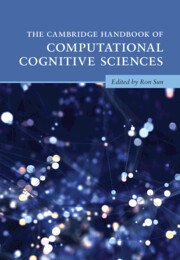Book contents
- The Cambridge Handbook of Computational Cognitive Sciences
- Cambridge Handbooks in Psychology
- The Cambridge Handbook of Computational Cognitive Sciences
- Copyright page
- Contents
- Preface
- Contributors
- Part I Introduction
- Part II Cognitive Modeling Paradigms
- Part III Computational Modeling of Basic Cognitive Functionalities
- Part IV Computational Modeling in Various Cognitive Fields
- 23 Computational Models of Developmental Psychology
- 24 Computational Models in Personality and Social Psychology
- 25 Computational Modeling in Industrial-Organizational Psychology
- 26 Computational Modeling in Psychiatry
- 27 Computational Psycholinguistics
- 28 Natural Language Understanding and Generation
- 29 Computational Models of Creativity
- 30 Computational Models of Emotion and Cognition-Emotion Interaction
- 31 Computational Approaches to Morality
- 32 Cognitive Modeling in Social Simulation
- 33 Cognitive Modeling for Cognitive Engineering
- 34 Modeling Vision
- 35 Models of Multi-Level Motor Control
- Part V General Discussion
- Index
- References
27 - Computational Psycholinguistics
from Part IV - Computational Modeling in Various Cognitive Fields
Published online by Cambridge University Press: 21 April 2023
- The Cambridge Handbook of Computational Cognitive Sciences
- Cambridge Handbooks in Psychology
- The Cambridge Handbook of Computational Cognitive Sciences
- Copyright page
- Contents
- Preface
- Contributors
- Part I Introduction
- Part II Cognitive Modeling Paradigms
- Part III Computational Modeling of Basic Cognitive Functionalities
- Part IV Computational Modeling in Various Cognitive Fields
- 23 Computational Models of Developmental Psychology
- 24 Computational Models in Personality and Social Psychology
- 25 Computational Modeling in Industrial-Organizational Psychology
- 26 Computational Modeling in Psychiatry
- 27 Computational Psycholinguistics
- 28 Natural Language Understanding and Generation
- 29 Computational Models of Creativity
- 30 Computational Models of Emotion and Cognition-Emotion Interaction
- 31 Computational Approaches to Morality
- 32 Cognitive Modeling in Social Simulation
- 33 Cognitive Modeling for Cognitive Engineering
- 34 Modeling Vision
- 35 Models of Multi-Level Motor Control
- Part V General Discussion
- Index
- References
Summary
Computational psycholinguistics seeks to develop computational theories and implemented models of the cognitive systems that map an unfolding linguistic signal onto a mental representation of its meaning. Focusing primarily on language comprehension, this chapter begins with early theories of sentence processing, before reviewing several prominent implemented computational models. These accounts are largely informed by reading-time studies that seek to establish the strategies and constraints that determine how people resolve ambiguity. This review concludes with a more in-depth discussion of rational probabilistic accounts, for which there has been considerable consensus in recent years, and surprisal theory, which formally links these models with measures of human comprehension effort, such as reading times and brain potentials. Finally, an implemented neurobehavioral model of language comprehension is presented in greater detail, illustrating the benefit of linking computational models with several behavioral and neurophysiological indices of human comprehension, as well as the importance of looking beyond syntactic processing alone to the modeling of semantic comprehension and the role of world knowledge.
Keywords
- Type
- Chapter
- Information
- The Cambridge Handbook of Computational Cognitive Sciences , pp. 890 - 920Publisher: Cambridge University PressPrint publication year: 2023



